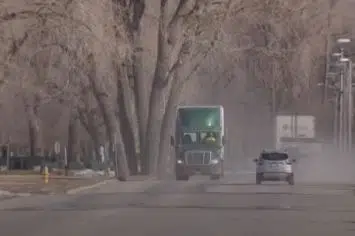GREEN BAY, WI (WTAQ-WLUK) – If you’ve driven in the winter around Northeast Wisconsin, you’ve probably noticed the white lines on the road from time to time.
Liquid brine treatments have been steadily taking the place of traditional rock salt on roads.
This past March, Green Bay Public Works director Steve Grenier said the city’s salt usage had dropped significantly due to the practice.
“I don’t think we’re out of the ballpark if we say we’ve probably seen a 2500 ton reduction. We’re probably between that 25 and 30 percent reduction.
Newly released this week, a University of Wisconsin study funded by the Wisconsin department of transportation lends credence to Genier’s figures.
The report estimates brine decreases salt usage by 23 percent, and it says counties studied cleared snow and ice about 2 hours faster using brine versus traditional methods.
When it comes to cutting costs and increasing effectiveness, brine is an absolute success.
But in other areas, the brine takeover isn’t without some drawbacks.
Ray VandeVelden is the owner of MJ Collision Center in Bellevue. He tells FOX 11 the dust that the dried brine kicks up is worse for cars than traditional rock salt.
“We see a lot more newer vehicles in the 6 months to 3 to 4 year range with a lot more corrosion on the bottom of them than we used to… it’s a lot finer dust that’s traveling up, going higher up into underneath the vehicle… places that normally spray and splash and water and stuff wouldn’t get.”
That includes places that you can’t even really clean, like behind plastic panels and inside small metal seams and rivets.
But as long as Wisconsin sees snow and ice, the roads will see brine and salt to keep drivers safe.
VandeVelden says it’s even more important to wash your car now that brining has become so popular.
Even if you know it’ll just get dirty again, frequent washes help keep that salt from accumulating and becoming even more of a problem down the road.





